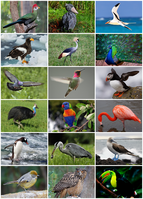
Human faces and face‐like stimuli are more memorable
Sign Up to like & getrecommendations! Published in 2022 at "Psych Journal"
DOI: 10.1002/pchj.564
Abstract: Abstract We have previously suggested a distinction in the brain processes governing biological and artifactual stimuli. One of the best examples of the biological category consists of human faces, the perception of which appears to… read more here.
Keywords: face like; real human; face; memorability ... See more keywords

A songbird strategically modifies its blinking behavior when viewing human faces.
Sign Up to like & getrecommendations! Published in 2021 at "Animal cognition"
DOI: 10.1007/s10071-021-01476-6
Abstract: Even though blinking is necessary to maintain clear vision in many species, blinking is likely costly because it temporarily impairs vision. Given this cost, individuals can strategically modify their blinking behavior to minimize information loss.… read more here.
Keywords: viewing human; human faces; songbird strategically; behavior viewing ... See more keywords

The effect of intranasal oxytocin on visual processing and salience of human faces
Sign Up to like & getrecommendations! Published in 2020 at "Translational Psychiatry"
DOI: 10.1038/s41398-020-00991-3
Abstract: The mechanisms underlying the role of oxytocin (OT) as a regulator of social behavior in mammals are only partly understood. Recently, it has been proposed that OT increases the salience of social stimuli. We carried… read more here.
Keywords: salience human; human faces; effect intranasal; effect ... See more keywords

Predictive validation of Ugandan infant eye-tracking test for memory of human faces
Sign Up to like & getrecommendations! Published in 2022 at "Child Neuropsychology"
DOI: 10.1080/09297049.2022.2099537
Abstract: ABSTRACT We provide initial evidence that an eye-tracking based measure of infant attention and working memory (gaze preference for novel human faces) can predict aspects of neurocognitive performance years later among Ugandan children. 49 HIV-exposed/uninfected… read more here.
Keywords: eye tracking; predictive validation; eye; infant ... See more keywords

A shared mechanism for facial expression in human faces and face pareidolia
Sign Up to like & getrecommendations! Published in 2021 at "Proceedings of the Royal Society B: Biological Sciences"
DOI: 10.1098/rspb.2021.0966
Abstract: Facial expressions are vital for social communication, yet the underlying mechanisms are still being discovered. Illusory faces perceived in objects (face pareidolia) are errors of face detection that share some neural mechanisms with human face… read more here.
Keywords: mechanism; human faces; expression; facial expression ... See more keywords

Makeup Lamps: Live Augmentation of Human Faces via Projection
Sign Up to like & getrecommendations! Published in 2017 at "Computer Graphics Forum"
DOI: 10.1111/cgf.13128
Abstract: We propose the first system for live dynamic augmentation of human faces. Using projector‐based illumination, we alter the appearance of human performers during novel performances. The key challenge of live augmentation is latency — an… read more here.
Keywords: system; human faces; live augmentation; augmentation human ... See more keywords

Face Pareidolia Recruits Mechanisms for Detecting Human Social Attention
Sign Up to like & getrecommendations! Published in 2020 at "Psychological Science"
DOI: 10.1177/0956797620924814
Abstract: Face pareidolia is the phenomenon of seeing facelike structures in everyday objects. Here, we tested the hypothesis that face pareidolia, rather than being limited to a cognitive or mnemonic association, reflects the activation of visual… read more here.
Keywords: human faces; pareidolia recruits; face; face pareidolia ... See more keywords